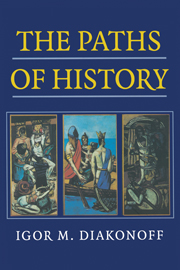Book contents
- Frontmatter
- Contents
- Foreword by Geoffrey Hoskins
- Preface
- Introduction
- 1 First Phase (Primitive)
- 2 Second Phase (Primitive Communal)
- 3 Third Phase (Early Antiquity)
- 4 Fourth Phase (Imperial Antiquity)
- 5 Fifth Phase (the Middle Ages)
- 6 Sixth Phase (the Stable Absolutist Post-Medieval Phase)
- 7 Seventh Phase (Capitalist)
- 8 Eighth Phase (Post-Capitalist)
- Index
5 - Fifth Phase (the Middle Ages)
Published online by Cambridge University Press: 02 December 2009
- Frontmatter
- Contents
- Foreword by Geoffrey Hoskins
- Preface
- Introduction
- 1 First Phase (Primitive)
- 2 Second Phase (Primitive Communal)
- 3 Third Phase (Early Antiquity)
- 4 Fourth Phase (Imperial Antiquity)
- 5 Fifth Phase (the Middle Ages)
- 6 Sixth Phase (the Stable Absolutist Post-Medieval Phase)
- 7 Seventh Phase (Capitalist)
- 8 Eighth Phase (Post-Capitalist)
- Index
Summary
Modern historical terminology and periodisation is usually (at least in this country) based on the experience of Europe alone: as to the Asiatic societies, the Marxists class them by ‘formations’ quite mechanically; certain forms are explained as ‘feudal’, although very often in these societies a feudal class in the European sense did not exist.
Actually, during this particular segment of the historical process it was Europe that differed considerably from the rest of the world, while the Asiatic ways of development were typical. The peculiarity of European development was partly conditioned by the tradition of ideas belonging to Imperial Antiquity; the breaking with the traditions of polis structures and ideology was an immensely slow process; moreover, the historical situation in which the crisis of Imperial Antiquity took place was very specific. The specificity of the situation was created, first, through the occupation of considerable territories which had already passed both the Chiefdom Phase, and the Early as well as the Imperial Antiquity, by Germanic and Slavic Late Primitive chiefdoms which at that time were going through a very mobile stage; and secondly, by devastating intrusions of nomadic hordes.
But before we examine the causes, the prerequisites, and the peculiarities of the next, Fifth, Phase of the historical process, as it developed among the agricultural and industrial population, it is advisable to dwell (very shortly) on the peculiar nomadic variety of the human race.
The division of labour between agriculturists and artisans, on the one hand, and the cattle-breeders on the other goes back to the Second (Primitive Communal) Phase.
- Type
- Chapter
- Information
- The Paths of History , pp. 56 - 143Publisher: Cambridge University PressPrint publication year: 1999

